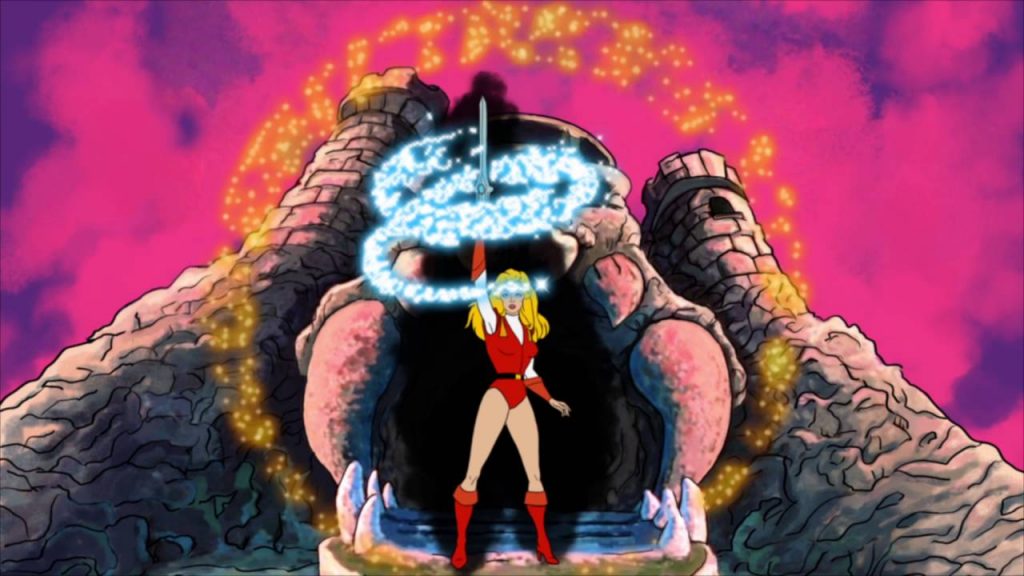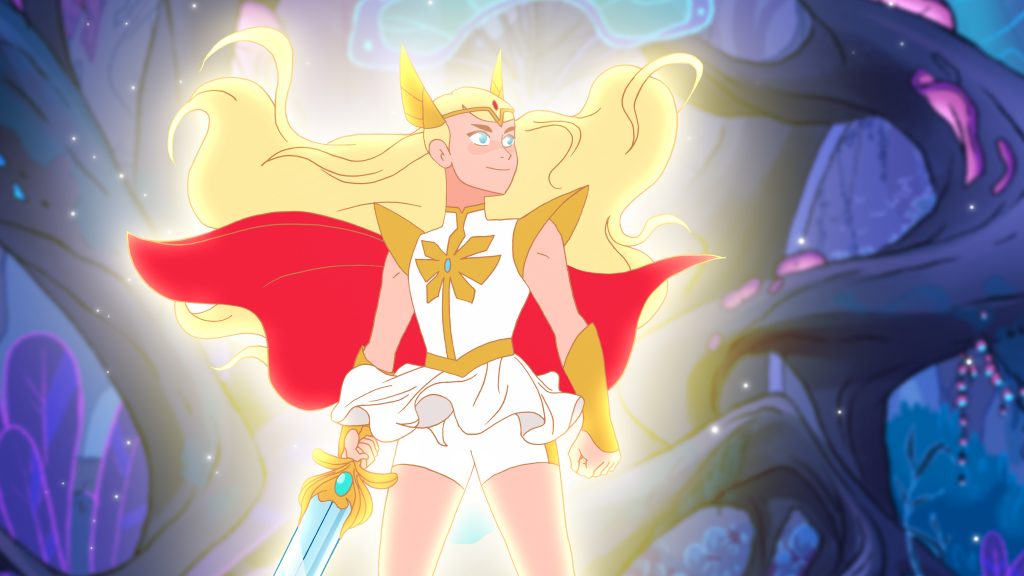
In 2020, the fifth and final season of She-Ra and the Princesses of Power (2018-2020) was released on Netflix. Headed by showrunner and Eisner award-winner Noelle Stevenson, She-Ra has received wide praise amongst fans and critics for its riveting storylines and positive queer representation. As a reboot of the classic Filmation series She-Ra: Princess of Power (1985-1987), Stevenson’s She-Ra (who when not in her Princess form is known as Adora) inevitably faced comparisons with her 1980s counterpart, not all of which were positive. Many of the responses to She-Ra’s redesign were sexist in nature, unfavorably comparing the ‘look’ of the Stevenson’s She-Ra to the 1980s original (see Abad-Santos, 2018; Robinson, 2018). In order to contextualize these comparisons, how do we frame Stevenson’s She-Ra in relation to the Filmation series? As a remake? Reboot? Adaptation? According to transmedia scholar William Proctor (2012, 4), terms such as ‘reboot’ and ‘remake’ are often conflated, but they are not “conjoined entities without distinction”. For Proctor, a remake refers to a “singular text” with a self-contained narrative, whereas a reboot “re-starts” (ibid.). Although Proctor is primarily describing film reboots and remakes, I find the term ‘reboot’ applicable to TV series as well.
There is also the question of adaptation, another term often conflated with remake and reboot, which conjures up a series of other associated terms including revising, revision, transposing, transforming, and altering, to name a few. According to Linda Hutcheon and Siobhan O’Flynn (2013, 8-9), adaptation may be understood as a “transposition” or a “creative and an interpretative act of appropriation”. An adaptation is “a derivation that is not derivative”. Stevenson’s She-Ra can also be understood in this way. She-Ra and the Princesses of Power alters, updates, and revises key aspects of the 1980s series in terms of characterization, narrative, and design. While the contemporary series shares and retains a number of aspects of its source, it is the changes between the texts which open up space for us to productively consider, as Carlen Lavigne (2014, 9) suggests, the “changing social and political contexts.”
The original She-Ra was first introduced to the world by toy company Mattel and production company Filmation, following the success of He-Man and the Masters of the Universe (1983-1985). In the 2017 documentary Power of Grayskull (dir. Randall Lobb & Robert McCallum), former director of marketing at Mattel, Janice Varney-Hamlin states:
We just decided, well if we’re gonna do a female fashion action doll, she might as well ride on the coattails of the popularity and awareness of this huge iconic brand called He-Man.
Stevenson’s series takes the opportunity to expand upon the original She-Ra storyworld through the narrative and the development of the characters. The biggest change, of course, is to She-Ra herself. This does not mean, however, that she has been completely stripped of her relation to her predecessor. In both series, Adora transforms into She-Ra by holding aloft her sword and crying: “For the honor of Grayskull!” In the 1985 series, this transformation mirrored that of Prince Adam/He-Man (who would instead cry “By the power of Grayskull!”). Adora’s change into She-Ra is marked by the magical transformation of her outfit and the slight deepening of her voice. In Stevenson’s She-Ra, the transformation sequence is much more elaborate. Adora visibly grows more muscular and taller, although her voice does not change. Whereas Filmation She-Ra prefers to use her intelligence and wits to defeat her enemies, her physical strength is sometimes demonstrated as she lifts and throws them. The DreamWorks TV series however allows characters to fight using both weapons and magic, and Adora’s strength is showcased often. Stevenson’s series also does much to deconstruct and expand on the mythology of the titular ‘Princess of Power’ (but to fully unpack these implications is beyond the scope of this piece).

Perhaps predictably, even before She-Ra and the Princesses of Power was released, there was some level of ‘controversy’ regarding the characters’ new design. When Noelle Stevenson released some preview images of the new characters on her Twitter feed, certain fans of the original show were quick to criticise the new designs and complain about the differences. Some said she looked too much like ‘a dude’ or too ‘boyish’, or that she was no longer a ‘beautiful woman’. Responding to this backlash after the premiere of season one, Stevenson stated:
I do feel that as members of the media, we have a responsibility to show people as they really exist in the world, and that expands the boundaries of what you believe that you can do in the world. There are characters who are chubbier than they are in the original, but I wanted to show that that did not keep them from being free and powerful, like other characters. They can fly, they can teleport, they’re very nimble, they’re very scrappy, and they never back down from the battle (Stevenson in Jackson 2018).
It is also significant to note that, as ‘fans’ of the original She-Ra lamented her new look, designers of the original heroine were also forced to contend with sexist objectification. Justine Dantzer, a development designer at Mattel speaks of wanting the warrior princess to embody “a feeling of strength, not a feeling of high-heeled, ‘can’t hardly move’ slimness.” However, even in development meetings, Dantzer couldn’t escape sexist remarks:
The men would say, ‘Oh my god, look at those legs,’ when I would show drawings. There were times when I was very, very disgusted hearing about men’s opinions about women’s bodies, ad infinitum (Dantzer in Power of Grayskull, 2017).
According to Proctor (2012, 5), “rebooting a franchise does not imply that its core memory is destroyed. In other words, pressing the reboot button does not eradicate the iconographic memory of the cultural product.” Stevenson’s She-Ra does not displace or reduce the cultural impact of her Filmation predecessor, who was a rare female heroine on screen who was at least as popular (if not more so) than her twin brother. Indeed, considering the reincarnation as reboot allows us to contextualize the (minimal) backlash the series faced, and further appreciate the positive implications of the series revisions.
References
Abad-Santos, Alex (2018). “The Fight over She-Ra’s Netflix Redesign, Explained.” Vox, 18 July, www.vox.com/2018/7/18/17585950/she-ra-redesign-controversy-netflix [Accessed 17 June 2020]
Hutcheon, Linda, and Siobhan O’Flynn (2013). A Theory of Adaptation. New York: Routledge.
Jackson, Chelsea (2018). “Showrunner Noelle Stevenson Gave Us the Rundown on Everything She-Ra.” The Mary Sue, 14 November,www.themarysue.com/she-ra-princesses-power-noelle-stevenson-interview/ [Accessed 17 June 2020].
Lavigne, Carlen (2014). Introduction, in C. Lavigne (ed.), Remake Television: Reboot, Re-Use, Recycle, Lanham: Lexington Books, pp. 7-10.
Power of Grayskull: The Definitive History of He-Man and the Masters of the Universe. Directed by Randall Lobb and Robert McCallum, Definitive Film, 2017.
Proctor, William (2012). “Regeneration and Rebirth: Anatomy of the Franchise Reboot.” Scope: An Online Journal of Film and Television Studies 22, pp.1-19
Robinson, Tasha (2018). “Fan Artists Discuss Why the Wave of She-Ra Fan Art Is Subversive and Uplifting.” The Verge, 25 July, www.theverge.com/2018/7/25/17596576/she-ra-and-the-princesses-of-power-fan-art-subversive-netflix-fandom-community [Accessed 17 June 2020].
Ruth Richards recently completed her Ph.D. in Media and Communication at RMIT University. Her thesis was situated at the intersection of animation studies and feminist theory, exploring the nature of the animated body through feminist materialist frameworks. She teaches cinema studies, popular culture, and multi-camera television production.
